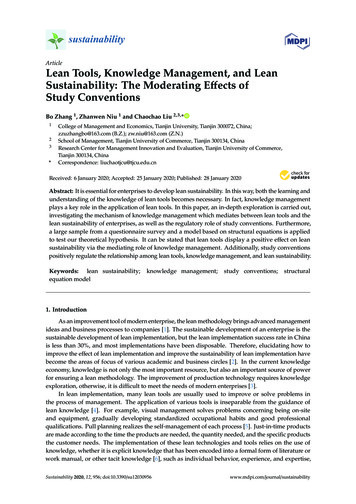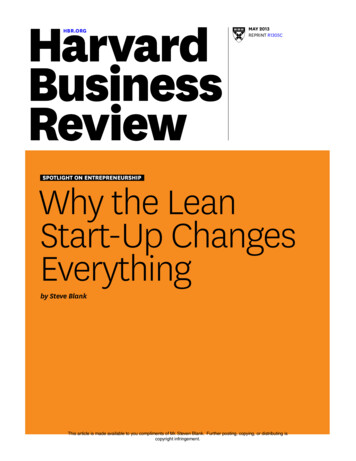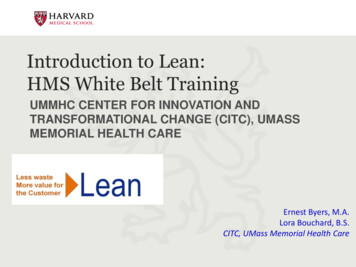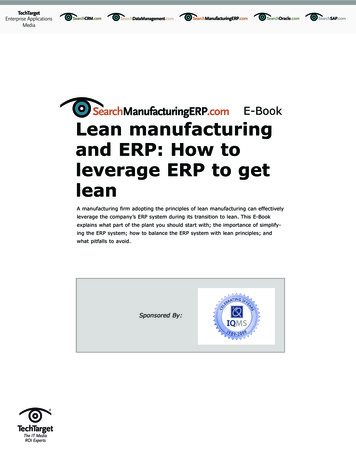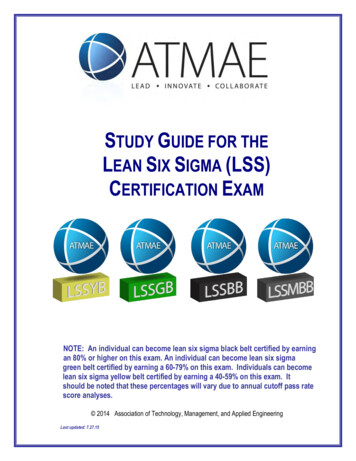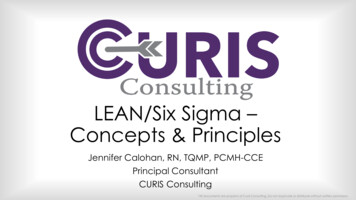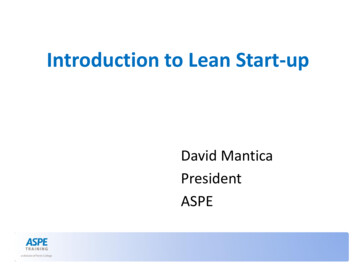
Transcription
Introduction to Lean Start-upDavid ManticaPresidentASPE
Presentation Agenda Product Theory 101What is AgileFundamentals of LeanDefinition of Lean Start-upLean start-up model overviewStage gate vs Lean start upDetails on Lean Start-upFundamentals of start-upTeam dynamics necessary for Lean Start-upLean Start-Up books
Presentation ObjectiveLearn the fundamentals of Lean Start-up and gainpractical real-world examples on how it isconducted
Product Development TheoryThree Critical Elements in Product titiveUnderstandingSource: Rebecca Henderson, Professor, Sloan School of Management, MIT
What is Value CreationValueCreationHow do you create value?
What is Organizational Capability?Do we have the organizationalcapabilities to deliver it?Do we have the right audience in our databases?Do we have the sales model?Do we have the human resources needed?OrganizationalCapability
What is Competitive UnderstandingCan we capture business inthe face of competition?What are others doing?CompetitiveUnderstanding
UniverseS-Curve Model: Product LifecycleMaturityTake OffFermentTimeSource: Rebecca Henderson, Professor, Sloan School of Management, MIT
Edison Product Factory—ASPE exampleDiversity of inputs to build ideas and using core revenue to fund new ideasCustomersKeyword ImpressionsCompetitive ResearchEvaluation dataCustomer call backsFocus groups, direct customer interviewsSurveysVendorsTrade publicationsOwned Database MakeupInformationProcessingIdea-False positives-False negativesTesting in the openmarket
Agile Manifesto, new way of workingWe are uncovering better ways of developing software by doing it and helpingothers do it. Through this work we have come to value:Individuals and interactions over processes and toolsWorking product over comprehensive documentationCustomer collaboration over contract negotiationResponding to change over following a planThat is, while there is value in the items onthe right, we value the items on the left more.It is a push for people over process & systemsIt means major change for attitude and prospective and workingBehaviors and Actions must changehttp://agilemanifesto.org
What is Lean? The core idea is to maximize customer value while minimizingwaste. A lean organization understands customer value and focusesits key processes to continuously increase it. The ultimate goal: provide value to the customer through avalue creation process that has zero waste. Optimize the WholeLean.org
Lean Concepts Relentlessly eliminate anything that isn’t adding valueEliminate time spent on what “we know” we’ll need in futureEliminate inefficient ways of workingOptimize the whole systemPeople doing the work know best how to do itMapping processes and improvingWoMBaT: Waste of Money, Brains, and TimeLean Start-Up takes a lean thinking approach todeveloping new products.
What is Lean Startup? Application of Lean thinking tothe process of innovation Adapts Lean ideas in context ofentrepreneurship Principle approach to newproduct development Guidance on how to maketrade-off decisions Focuses on Validated LearningLean Startup: Set of practicesto help entrepreneurs increasetheir odds of building asuccessful startup.Eric Ries, The Lean Startup
Lean Startup OverviewInputVisionStrategyBusiness PlanAssumptionsOutputGrowthExperimentsProduct IterationsLearningsPivotsSustainability?
Why Lean Startup? Traditional approaches tomanagement don’t always workwith Startups Approach for “continuousinnovation” Start-up success can beengineered with right process Startups must be managed Help recognize when to pivot andwhen to persevereStartups: Human institutiondesigned to create newproducts and services underconditions of extremeuncertainty
Benefits Business plans, forecasts are difficult to createin totally new product space– Customers can’t tell you what they want becausethey haven’t seen it or conceptualize how theywould use it– Customers don’t know what they want in advance Customer focused development Get rapid feedback, adapt quickly Strategy based on validated assumptions Pivot to reflect learnings Accounting techniques to support the work ofinnovation
What Lean Start-Up Is Not - Not your traditional way tocreate new products Not a collection of individualtactics Not a rigid, lockstep process Not a lack of discipline Not a software developmentmethodology Silver Bullet – Doesn’t fixeverything
The Stage-Gate Process Alternative to Lean StartupProcess containing methods & tools for New Product Development“Idea to Launch” processes, procedures, and controlsBreaks process into smaller Stages (containing activities) and Gates(Go/Kill decisions) Each Stage gathers more info, reduces risk, raises cost
Stage-Gate vs. Lean StartupStage-GateLean StartupTreats entrepreneurship as managementTreats entrepreneurship as managementRough conceptual productMinimum Viable ProductSpiral DevelopmentBuild-Measure-Learn LoopLaunch is endpointOpen-ended processLimited iterationsEncourages iterationsGo/Kill/Hold/Recycle DecisionsPivot or Persevere DecisionsLimited relevance to high-tech innovationHighly responsive high-tech innovationTraditional Business PlansBusiness Model CanvasStartEndStartEndFinalizing a ProductAchieving SustainabilityHow do we build this?Should we build this?Release a refined final productRelease to test assumptionsRevenue generated with final productMay generate revenue during process
Lean Analytics StagesEmpathy Are you solving a problem people care about and will pay for? Identify a real problem and real solution Get out of the Building, Interviews, SurveysStickiness Will the dogs eat the dog food? Leverage the solution with a small, friendly audience Test before going after the massesVirality Will people spread the word? Acquisition, Onboarding processes Force multiplier for paid promotionRevenueScale Will they open their pocketbooks? Monetize Product, Can you make money? Focus on maximizing and optimizing revenue Can we grow the market with sustainability? Acquire customers, expand verticals and geographies Channels, ecosystem, sustainability
Stage Example – RestaurantEmpathy Owner learns about diners in area Desires, trends, foods not available Gets out of building and talks to dinersStickiness Develops menu Lots of tests on customers, frequent changes High costs, variation, uncertain inventory, giveawaysViralityRevenueScale Starts loyalty programs to entice return customers Encourage customers to share with friends, friend coupons Leverages social media Work on margins Fewer free meals, tighter cost controls More standardization Proven sustainability Spends on marketing and promotion from revenues, broader advertising Launches second restaurant
Lean Startup Concepts
Lean Startup Principles1.2.3.4.5.Entrepreneurs are everywhereEntrepreneurship is managementProduct Success depends on learningBuild-Measure-Learn CycleMeasure LearningLean Start-Up is a set of practices to helpentrepreneurs increase their odds of building asuccessful Startup.
Lean Startup TenantsTest andLearnQuicklyObserve &MeasureCustomerBehaviorReleaseoften &earlyLeanStartupTenantsStay LeanEmbraceInnovationAccountingFocus onActionableMetricsBecomfortablePivoting
What is a Startup? An acutely human enterprise Includes Entrepreneurs andIntrapreneurs Catalyst that transforms ideas intoproducts Examples:– New Innovation– Scientific discoveries– Repurposing existing technology fornew use– New business model– Product/Service to new location– Address underserved set ofcustomers– New internal serviceStart-Ups: Human institutiondesigned to create newproducts and services underconditions of extremeuncertaintyEric Ries, The Lean Startup
Type of Start up Activity Entrepreneurship Intrapreneurship Spin out Spin in / Aquisition
Types of Innovation Sustaining Innovation– Improvements to existing product– Serving existing customers– Most companies are good but Disruptive Innovation– Breakthrough new products– New sustainable sources of growth– Companies struggle
Start-Up ModelProduct OptimizationStrategyVisionPivots
Value and Growth 2 Important Assumptions– Value hypothesis Customers find product valuable Does product or service delivervalue to customer once they use it? Value creating or value destroying– Growth hypothesis Reasons behind product’s growth How will new customers discoverproduct?
Leap-of-Faith Assumptions Strategy is based on assumptions Strategy takes assumptions as agiven and shows how to achieveVision Goal: Test these assumptions assoon as possible Confirm make or break assumptions– Based on reality?– Real problem?
Build-Measure-Learn Feedback LoopEric Ries, The Lean Startup
Build Phase Minimum Viable Product (MVP)Fastest full turn of cycleMinimum amount of effortMinimum developmentStart learning as quickly as possible– Any work beyond is waste Answer product design or technical questions Test fundamental hypotheses Usually overestimate needs for MVP– When in doubt, simplify
Measure Phase Are development efforts leading to realprogress “Metrics are people, too”– Represents breathing, thinking, buyingindividuals– Behavior is measureable and changeable Are you making your product better? How do you know?
Role of the Product Owner Leads the Startup as the EntrepreneurEmpowered to own product on behalf of thecompanyResponsible for the product successLeads the team by conveying Product Visionto the teamDevelops and manages the Product RoadmapDefines and prioritizes the work in thebacklog based on business valueWorks directly with the development team tofacilitate their workManages Stakeholders needs andexpectationsThere is only ONE Product Owner
The Startup TeamTeamMemberComm SMEProduct TeamProductOwnerServantLeaders
Diversity Identity Diversity Cognitive Diversity
Types of Cognitive Diversity Diverse perspective – Political, Social, Religious viewpoints. Diverse interpretations – How the brain sees the darkshadow at night. How your ears hear a baby’s cry Diverse heuristics – Do you run, do you fight. Do you act thanthink or think than act Diverse predictive models
Books about Lean Start-up The Lean Start-Up by Eric Ries The Lean Entrepreneur by Brant Cooper andPatrick Vlaskovits
Thank you!!!I appreciate your time.David ManticaPresident, ASPE Training
Adapts Lean ideas in context of entrepreneurship Principle approach to new product development Guidance on how to make trade-off decisions Focuses on Validated Learning Lean Startup: Set of practices to help entrepreneurs increase their odds of building a successful start


